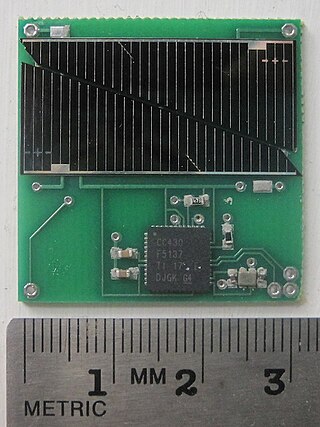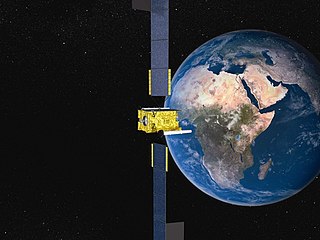
Mass media in Mexico are regulated by the Secretariat of Communication and Transportation, a federal executive cabinet ministry and by the Federal Telecommunications Institute.

Proton is an expendable launch system used for both commercial and Russian government space launches. The first Proton rocket was launched in 1965. Modern versions of the launch system are still in use as of 2023, making it one of the most successful heavy boosters in the history of spaceflight. The components of all Protons are manufactured in the Khrunichev State Research and Production Space Center factory in Moscow and Chemical Automatics Design Bureau in Voronezh, then transported to the Baikonur Cosmodrome, where they are assembled at Site 91 to form the launch vehicle. Following payload integration, the rocket is then brought to the launch pad horizontally by rail, and raised into vertical position for launch.

International Launch Services, Inc. (ILS) is a joint venture with exclusive rights to the worldwide sale of commercial Angara and Proton rocket launch services. Proton launches take place at the Baikonur Cosmodrome in Kazakhstan while Angara is launched from the Plesetsk and Vostochny Cosmodrome in Russia.

The Nimiq satellites are a Canadian fleet of geostationary telecommunications satellites owned by Telesat and used by satellite television providers including Bell Satellite TV and EchoStar. 'Nimiq' is an Inuit word used for an object or a force which binds things together. A contest in 1998 was held to choose the name of these satellites. The contest drew over 36,000 entries. Sheila Rogers, a physiotherapist from Nepean, Ontario, submitted the winning name.
Spaceway-3 is a communications satellite which was launched in August 2007. The third satellite in the Spaceway series, it includes a Ka-band communications payload. It is used by Hughes Network Systems to provide broadband Internet Protocol network service.

MEASAT-3 was a Malaysian communications satellite which was successfully launched on 11 December 2006 from the Baikonur Cosmodrome in Kazakhstan.
The Briz-K, Briz-KM and Briz-M are Russian liquid-propellant rocket orbit insertion upper stages manufactured by Khrunichev State Research and Production Space Center and used on the Proton-M and Angara A5. The upper stages were also used on Rokot, one of Russia's smaller launchers, before its retirement in 2019.
JCSAT-11, was a geostationary communications satellite ordered by JSAT Corporation which was designed and manufactured by Lockheed Martin on the A2100 platform. The satellite was designated to be used as an on-orbit, but was lost on launch failure.

ELA-3, is a launch pad and associated facilities at the Centre Spatial Guyanais in French Guiana. ELA-3 was operated by Arianespace as part of the expendable launch system for Ariane 5 launch vehicles. As of July 2023, 117 launches have been carried out from it, the first of which occurred on 4 June 1996. The final launch occurred on 5 July 2023.
ProtoStar Ltd was a private company incorporated in Bermuda, with U.S. operations based in San Francisco, California and Asian operations based in Singapore. ProtoStar intended to operate an initial fleet of three geostationary satellites. Two satellites were acquired and launched. ProtoStar's anchor customer, Dish TV India Limited, is the largest direct-to-home television operator in India.

The Morelos satellites are a series of Mexican communications satellites. The first two operated between 1985 and 1998 and provided telephony, data, and television services over the territory of the Mexican Republic and adjacent areas. The third is now part of the MEXSAT constellation but carries the Morelos name.
The DirecTV satellite fleet is a group of communications satellites located at various geostationary orbits that DirecTV uses for their satellite television service and HughesNet internet service. The "DirecTV" prefix in their names has been changed to "T".
Thor is a family of satellites designed, launched and tested by Hughes Space and Communications for British Satellite Broadcasting (BSB), and were used for Britain's Direct Broadcast Service. Thor is owned by Telenor. Marcopolo 1 launched on 27 August 1989 on the 187th launch of a Delta rocket, and Marcopolo 2 launched on 17 August 1990, on a Delta II rocket. Marcopolo I had the Hughes designation HS376.
JCSAT-RA, previously known as JCSAT-12, is a Japanese geostationary communications satellite, which is operated by SKY Perfect JSAT Group.
QuetzSat 1 is a Mexican high-power geostationary communications satellite which is operated by the Mexican operator QuetzSat It is positioned in geostationary orbit, and located at 77° West, from where it provides direct broadcasting services to United States and a part of Mexico for Dish Mexico.

Secondary payload, also known as rideshare payload, is a smaller-sized payload transported to orbit on a launch vehicle that is mostly paid for—and with the date and time of launch and the orbital trajectory determined—by the entity that contracts and pays for the primary launch. As a result, the secondary payload typically obtains a substantially reduced price for transportation services to orbit, by accepting a trade off of the loss of control once the contract is signed and the payload is delivered to the launch vehicle supplier for integration to the launch vehicle. These tradeoffs typically include having little or no control over the launch date/time, the final orbital parameters, or the ability to halt the launch and remove the payload should a payload failure occur during ground processing prior to launch, as the primary payload typically purchases all of these launch property rights via contract with the launch services provider.

Skynet 5D is a military communications satellite operated by Airbus Defence and Space on behalf of the British Ministry of Defence. It was the last of four Skynet 5 satellites to be launched.
Space launch market competition is the manifestation of market forces in the launch service provider business. In particular it is the trend of competitive dynamics among payload transport capabilities at diverse prices having a greater influence on launch purchasing than the traditional political considerations of country of manufacture or the national entity using, regulating or licensing the launch service.
Mexsat-3, also known as Mexsat Bicentenario or simply Bicentenario, is the first of three Mexican satellites forming the MEXSAT telecommunications network, and is named to commemorate the bicentennial of the Independence of Mexico. It was launched on 19 December 2012 to serve the other two satellites in the network, Mexsat-1 and Mexsat-2, as a fixed satellite service. It was manufactured by the company Orbital Sciences Corporation and was launched from Kourou in French Guiana, and currently occupies the orbit 114.9° West.
AMC-9 is a commercial broadcast communications satellite owned by SES World Skies, part of SES S.A. Launched on 6 June 2003, from Baikonur Cosmodrome, Kazakhstan, on the 300th launch of a Proton family rocket, AMC-9 is a hybrid C-band / Ku-band satellite located at 83° West, covering Canada, United States, Mexico, and Caribbean. It is owned and operated by SES S.A., formerly SES Americom.









